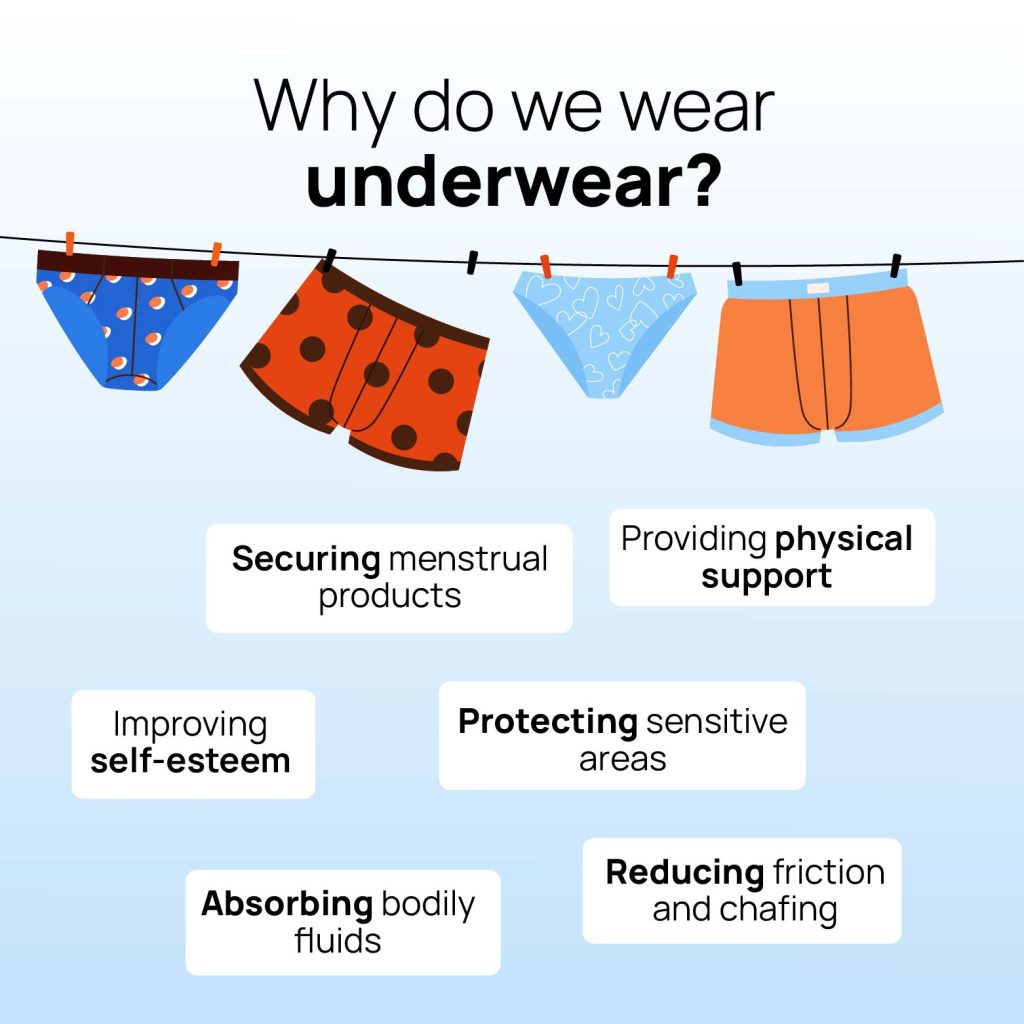
Selecting the appropriate undergarments can help lower the chance of irritations and infections. On the other hand, not wearing underwear might also be advantageous for preserving the condition of our intimate regions. Thus, what is the purpose of wearing underwear, and what effects do the kind of underwear we choose have on our bodies? Learn the value of underwear, why it is a good idea to go commando, and how to choose the right underwear for you.
Reasons why we wear underwear
Undergarments can be worn on their own or as an extra layer beneath clothes to maintain discretion, create a style statement, or even to provide a hint of seduction. These things have changed throughout time to fulfill a variety of functions, from small slips of material to slip dresses and t-shirts, and from embellishments that set the upper classes apart to basic items that met the needs of the working population.

Protecting sensitive areas
The primary purpose for which they have been used throughout human history has been protection. If you do not wear underwear, you run the risk of having your delicate parts rubbed raw by clothes that you wear a lot before washing them or of having friction between your skin and your clothing.
Absorbing bodily fluids
By shielding your clothes and communal surfaces from bodily fluids including sweat, urine, and small fecal leaks, these things can help you stay hygienic. Additionally, sweat-wicking clothing can lessen the possibility of chafing and irritations during vigorous exercises or in hot situations.
Reducing friction and chafing
Friction and chafing are common issues that can be prevented by wearing the right size and type of underwear. Trapped heat, moisture, and ill-fitting underwear can also promote yeast infections (vaginal candidiasis) or bacterial infections (such as UTIs and bacterial vaginosis) in individuals assigned female at birth and cause penile candidiasis, reduce sperm health, or chafing in individuals assigned male at birth.
This is especially an issue at high temperatures when the body can become very sweaty, or in the cold, when the skin can be drier and also more prone to cracking and irritation.
Providing physical support
Some objects have the ability to shape the body. Shapewear is frequently utilized to support a thinner or curvier appearance, whereas items with padding (like bras) may be used to provide extra support, pain relief, or to amplify curves.
Specialized products can support critical health needs. Examples of these products are the modern styles of maternity underwear or medical underwear, which includes those used following a vasectomy, c-section, stomach tuck, or to control incontinence.
Securing menstrual products
Underwear can also be helpful for maintaining menstrual hygiene while using pads and liners. Many such products come in the form of adhesive or ‘wings’ that can be used to secure them to your underwear or can even serve as menstrual underwear.
Improving self-esteem
Products like shapers or sweat-absorbing goods can boost a user’s confidence and sense of comfort. Because we favor a particular style, color, or pattern, some things can also be used only for aesthetic reasons to help us feel and look our best. There are some styles that can be used to increase sex appeal, such lingerie.
For example, one study showed that many women may choose certain types of underwear based on their sexual goals with their partner, with ‘sexy underwear’ serving as a potential subtle romantic signal.
How to choose the right underwear
With so many different styles and designs on the market, it’s important to understand how to choose the right ones, especially to reduce the risk of common infections, ingrown hairs, and other types of irritations due to friction or trapped heat and moisture. Here are a few tips to help you decide on the best underwear to use.

Choose the best fabric for your activities
Items made of breathable fabrics, like silk or cotton, are frequently advised for frequent and everyday use. By allowing air to circulate around your delicate areas while absorbing perspiration, these natural materials may help reduce the heat and humidity that can lead to odor, irritations, and infections.
To retain dryness and lessen friction, sweat-wicking clothing that is frequently replaced might be a better option for sports, exercise, or camping.
Choose the right size for you
When purchasing underwear, pay close attention to the sizing chart provided by the manufacturer. Ill-fitting underwear may do more harm than good by contributing to the risk of the same infections and irritations it is used to help prevent, and even negatively impact fertility, such as when using tight men’s underwear.
Select your best underwear style and/or design
Whatever style you choose—boyshorts, jockstraps, boxer briefs, or bikinis; underwire bras, bralettes, or compression undershirts—must be comfortable throughout the day, causing no pinching, digging, riding, rolling, or other discomforts.
Also, avoid using thongs and g-strings too often, as they can increase the risk of introducing bacteria from the colon into the sensitive areas.
How to take care of your underwear
Undergarments are more prone to wear and tear than other clothing pieces, despite being relatively affordable.
- Wash them after each use and according to the manufacturer’s guidance.
- Change them at least once a day.
- Replace them when worn out or in poor condition.
- Consider using fragrance-free laundering products as the chemicals in detergents and fabric softeners could cause irritation to sensitive areas.
- Use special underwear mesh bags for washing and use low heat or air drying more delicate items.
- Pack your clean, dry underwear away in well-ventilated locations protected from direct sunlight and dust.
Is it bad not to wear underwear?
While wearing underwear can be beneficial in many ways, it is not always required. Although wearing them could have advantages, there are other reasons why people might decide not to. No matter the style, fabric, or fit, some people find them to be tight, uncomfortable, and bothersome. Additionally, some experts recommend not wearing underwear in certain instances, such as during sleep.
However, failing to wear underwear can carry the same risks. Wearing tight, synthetic clothing, for instance, without underwear can restrict ventilation, trap moisture on the skin, and lead to chafing, friction, and infections. In the absence of an undergarment to act as a barrier, the central seams of most pants can be uncomfortable to wear. Additionally, utilizing clothes that are not cleaned often (like jeans) without wearing underwear exposes our delicate areas to bacteria.
All things considered, underwear is a solution that can be used for a number of reasons, including as satisfying a perceived need for modesty, removing annoyance and discomfort, or making a fashion statement. Selecting the incorrect underwear can raise the risk of infections and perhaps affect fertility, but the correct choice can help lower the risk.
The most crucial thing is to take care of your body by changing your underwear frequently, cleaning your sensitive areas, and taking proactive measures to address any itching, tightness, or other discomfort signals. Nevertheless, even if they are beneficial in many ways, wearing underwear is ultimately a personal choice.
What’s your viewpoint and experiences on choosing and using underwear today? Share with us in the comments below.
FAQ
Is it necessary to wear underwear?
No. It is not always necessary to wear underwear, despite what society conventions may suggest. When worn under garments on a regular basis, it may prove to be a more hygienic item. Furthermore, a lot of professionals advise not wearing underwear to bed in order to encourage nighttime ventilation.
Can wearing the wrong underwear affect your health?
It could. Too-tight, poorly maintained, or inappropriately styled or woven underwear for particular activities can really raise your risk of infections and irritations in your most vulnerable places and perhaps have a detrimental effect on your ability to conceive.
What happens if you don’t wear underwear?
Depending on the individual. Underwear may help avoid comparable irritation or pain for some people, while others may find it uncomfortable to wear underwear all the time. The secret is to listen to your body, select appropriate styles, and make sure your personal hygiene decisions and underwear usage choices complement each other.
How often should you change your underwear for hygiene purposes?
If you exercise during the day or engage in other activities that raise your body temperature and cause you to perspire more, you should change your underwear more frequently than once a day. Maintaining ventilation and avoiding perspiration as much as possible in your sensitive areas without drying out the skin are crucial in this situation.
Does the type of fabric in underwear matter for health?
White cotton full-coverage underwear is the greatest kind of underwear that has been demonstrated to assist preserve the health of your intimate areas and lower your chance of irritations, discomforts, and infections. The only exception to this rule are situations in which you wear sweat-wicking underwear while exercising or specialist items like incontinence or menstruation underwear.
Key takeaways:
- Underwear has a variety of functions, including as promoting sexual interest, upholding personal hygiene, and boosting self-esteem.
- Selecting the appropriate material, design, and fit for your needs is essential if you want to get the benefits of underwear.
- Some people may decide not to wear underwear because they are irritated or uncomfortable with it.
- Whether you wear underwear or not, make sure you always maintain the proper degree of hygiene to support the health of your sensitive areas.









Leave a Reply